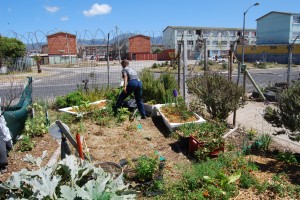 On < World Hunger Day I went to bed with a comfortably full stomach, while many millions around the world didn't. One of the Millennium Development Goals was to eradicate extreme poverty and hunger by 2015. This hasn't been achieved even with our present model of huge monoculture holdings. Perhaps the answer to eliminating world hunger lies in going small and changing what we eat and how we grow the food that we eat.
With our current agricultural model it takes at least 2 000 litres of water to produce enough food for one person for one day. Irrigation currently accounts for 70% of all water withdrawals worldwide, with some countries already using more than 40% of their renewable water resources for irrigation. By 2030 when the world needs 55% more food, we may have eaten our way to a thirsty future.
In terms of what we eat consider this - it takes 7 kgs of grain to add 1 kg of live weight to beef; 4 kgs of grain for 1 kg of pork; and 2 kgs of grain for 1 kg each of fish and poultry. People in the affluent West are eating the equivalent of 800 kgs of grain per year, mainly eaten indirectly in the form of beef, mutton, pork, poultry, milk, cheese and ice cream. While people in some undeveloped countries are eating less than 100 kgs of grain a year, eaten directly. This is disproportionate in terms of global agricultural carrying capacity.
More worrying, however, is how the world will feed itself as we are currently appropriating 40% of Net Primary Production (NPP) on land and within 60 years this figure could rise to as much as 80%, which means there will be little space for the plants that produce food.
On < World Hunger Day I went to bed with a comfortably full stomach, while many millions around the world didn't. One of the Millennium Development Goals was to eradicate extreme poverty and hunger by 2015. This hasn't been achieved even with our present model of huge monoculture holdings. Perhaps the answer to eliminating world hunger lies in going small and changing what we eat and how we grow the food that we eat.
With our current agricultural model it takes at least 2 000 litres of water to produce enough food for one person for one day. Irrigation currently accounts for 70% of all water withdrawals worldwide, with some countries already using more than 40% of their renewable water resources for irrigation. By 2030 when the world needs 55% more food, we may have eaten our way to a thirsty future.
In terms of what we eat consider this - it takes 7 kgs of grain to add 1 kg of live weight to beef; 4 kgs of grain for 1 kg of pork; and 2 kgs of grain for 1 kg each of fish and poultry. People in the affluent West are eating the equivalent of 800 kgs of grain per year, mainly eaten indirectly in the form of beef, mutton, pork, poultry, milk, cheese and ice cream. While people in some undeveloped countries are eating less than 100 kgs of grain a year, eaten directly. This is disproportionate in terms of global agricultural carrying capacity.
More worrying, however, is how the world will feed itself as we are currently appropriating 40% of Net Primary Production (NPP) on land and within 60 years this figure could rise to as much as 80%, which means there will be little space for the plants that produce food.
 By going small and utilising whatever resources are at hand and whatever space is available, people can take responsibility for their own food security.
By going small and utilising whatever resources are at hand and whatever space is available, people can take responsibility for their own food security.
Amazingly this is being achieved on the Cape Flats of South Africa, a crime-ravaged area beset by apathy, unemployment and substance abuse. It is an area characterised by underprivileged communities who live in grim housing blocks pockmarked by gunfire, or in shacks packed tightly together in the unmistakeable press of poverty. Yet from this unpromising environment, people who are being mentored by a Western Cape food growing initiative, Soil for Life, are growing food and in the process, food gardening is changing their lives.
By getting back to the basics of caring for the soil and growing the plants that feed us, it is possible for each of us to take matters into our own hands, ensuring that we have at least a measure of food security. This could be vital for survival in the time ahead. For more information about Soil for Life you can go to their website at www.soilforlife.co.za.

